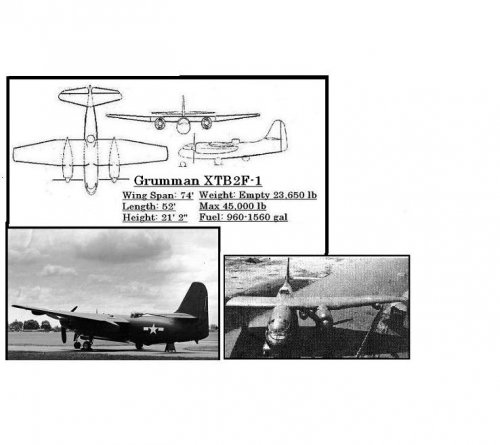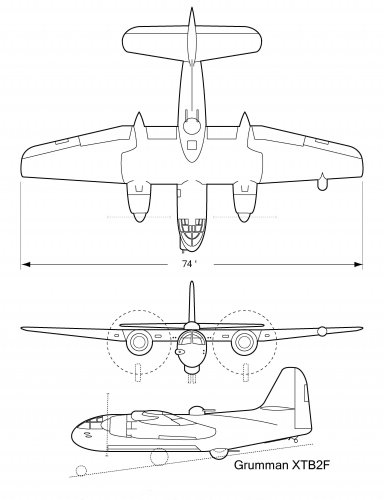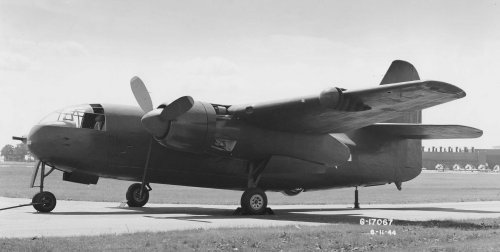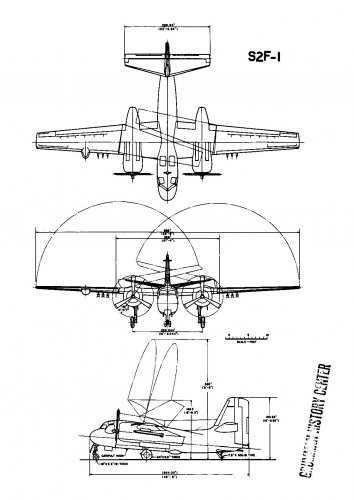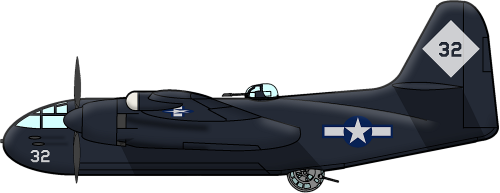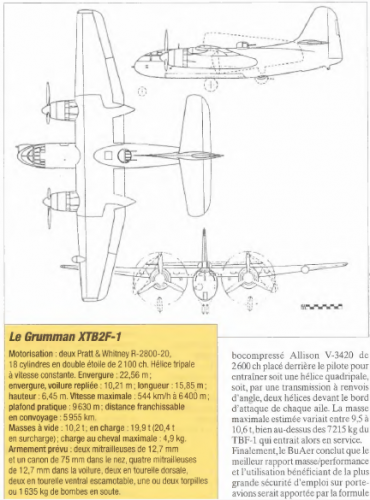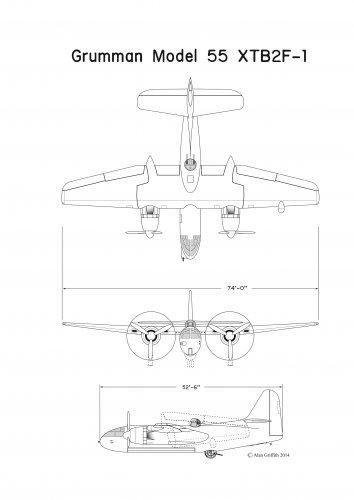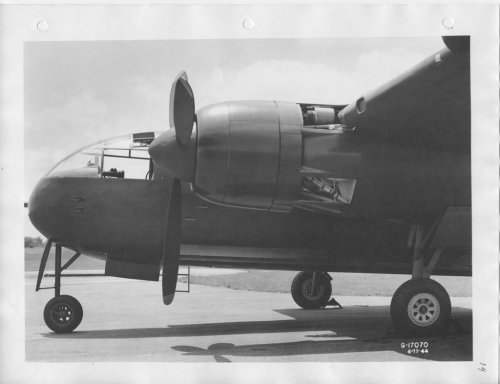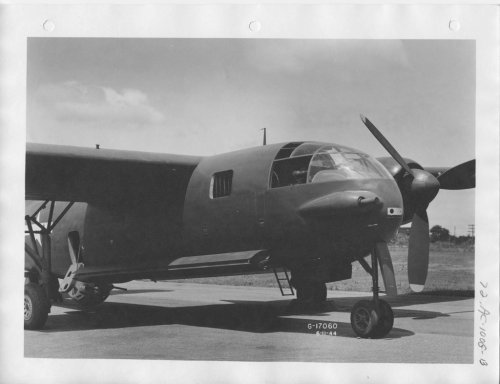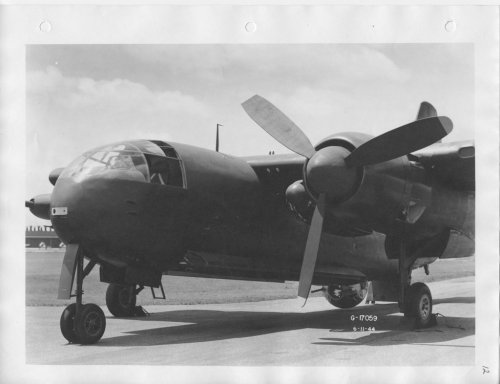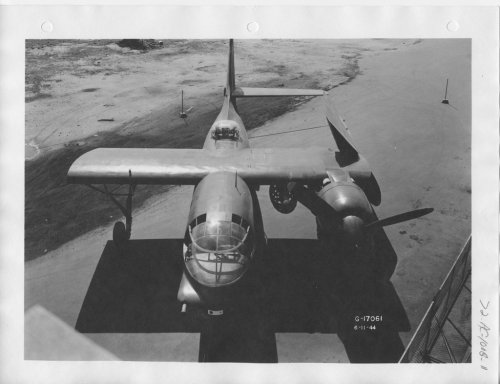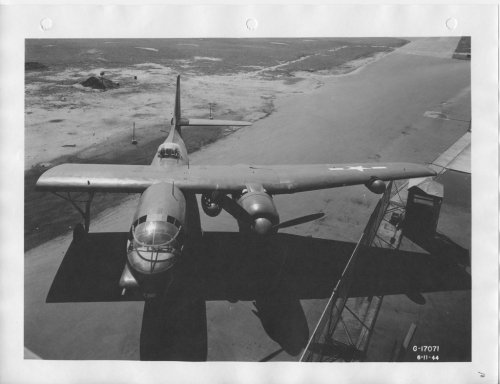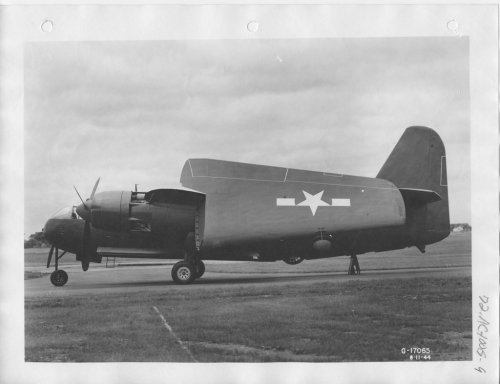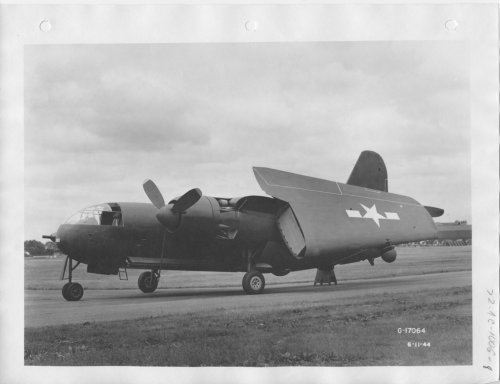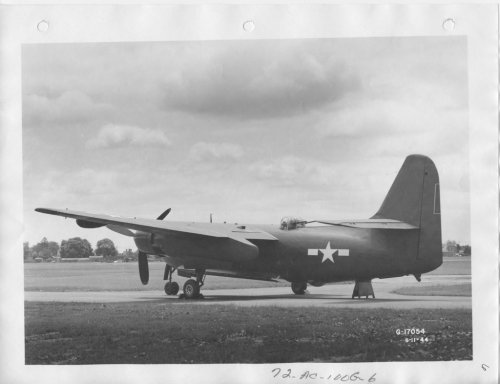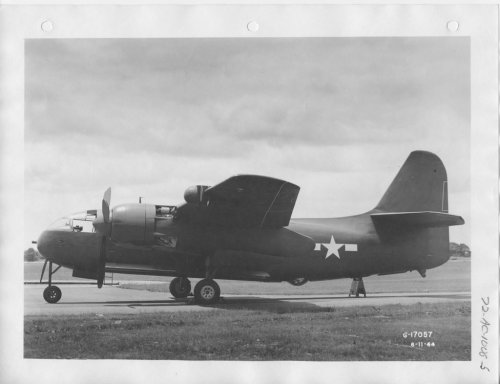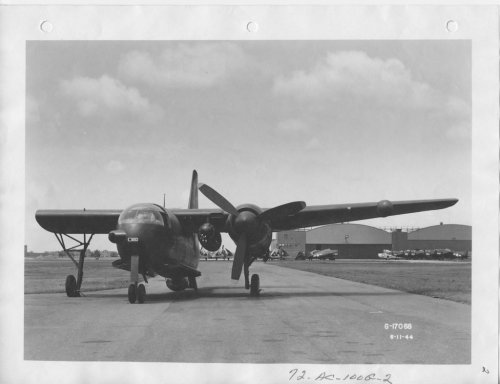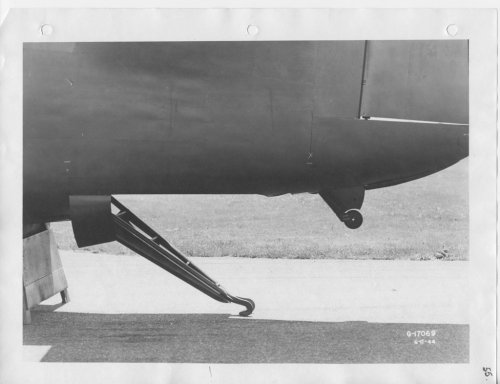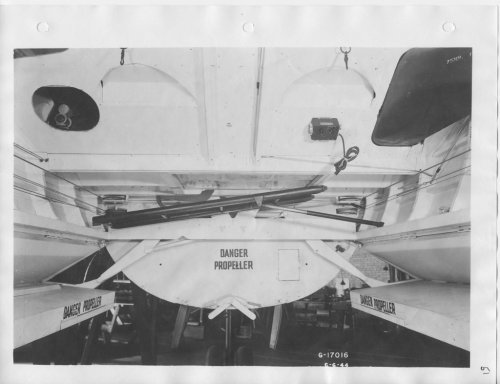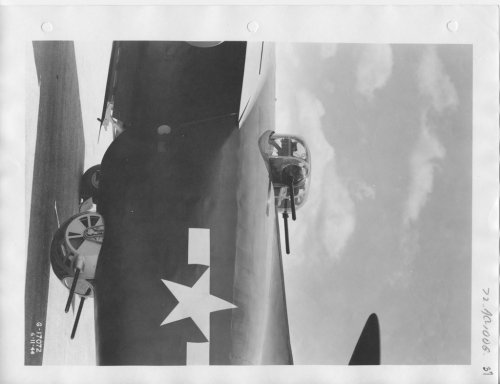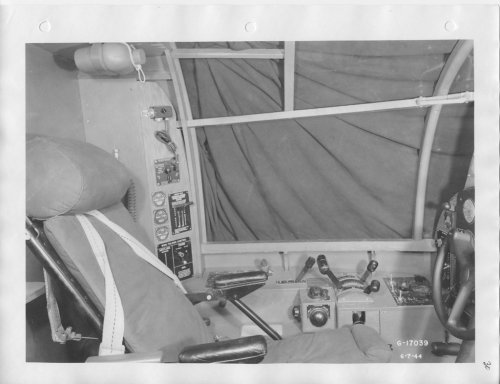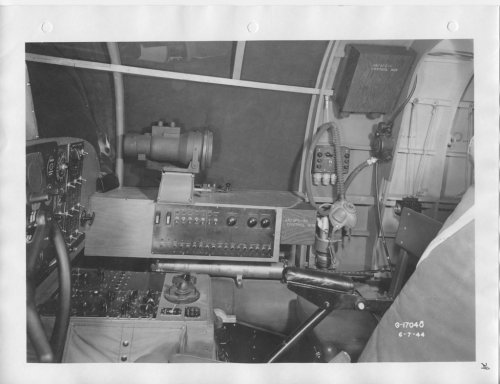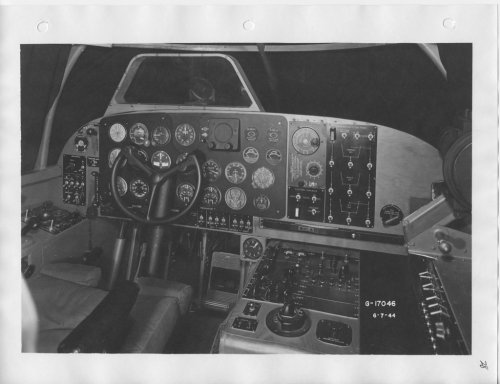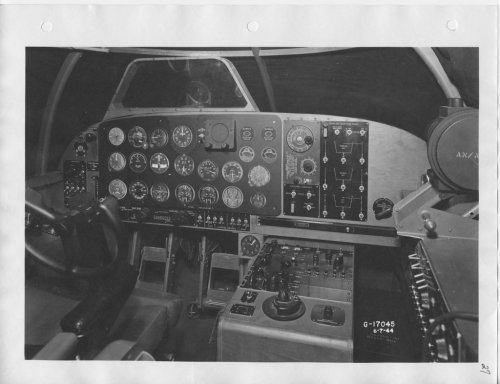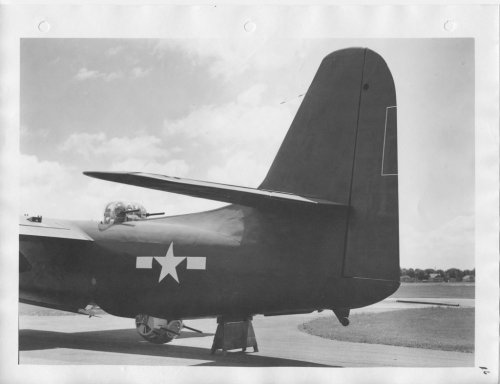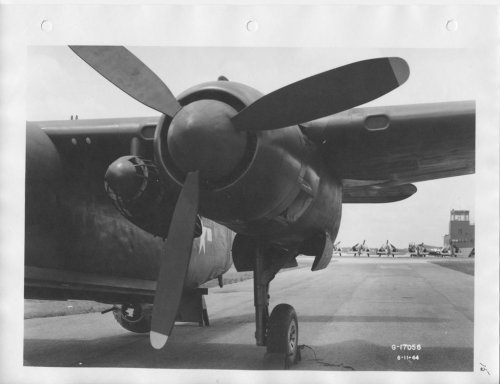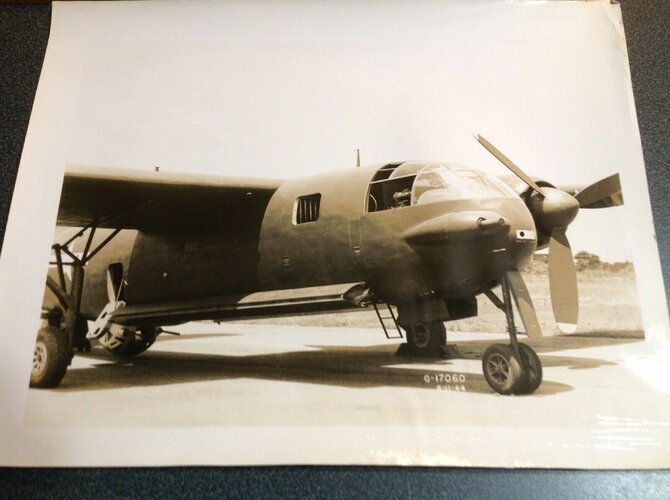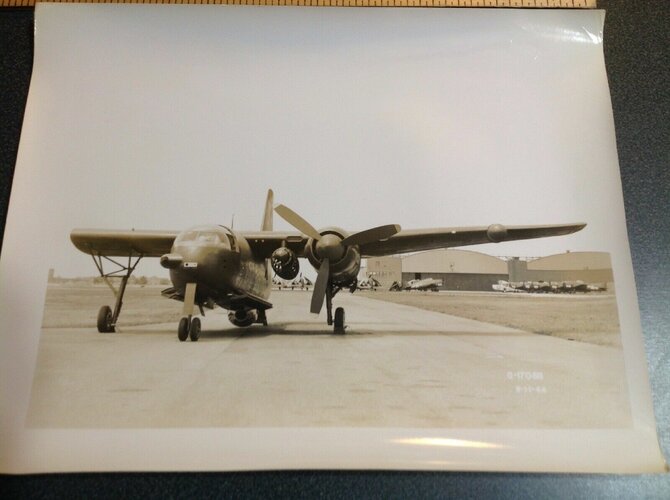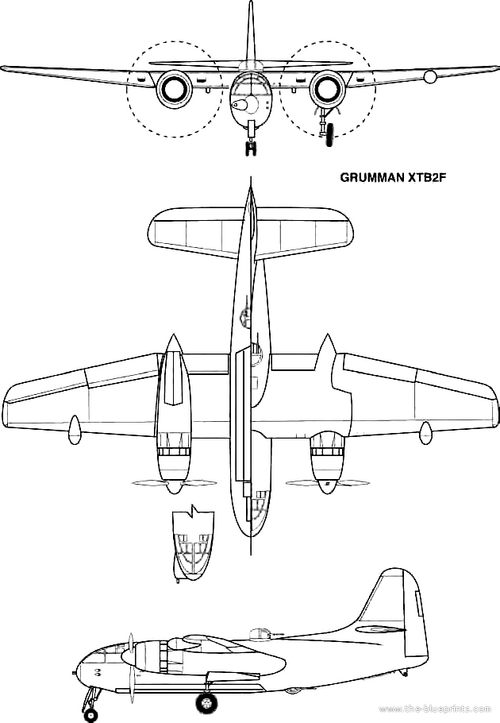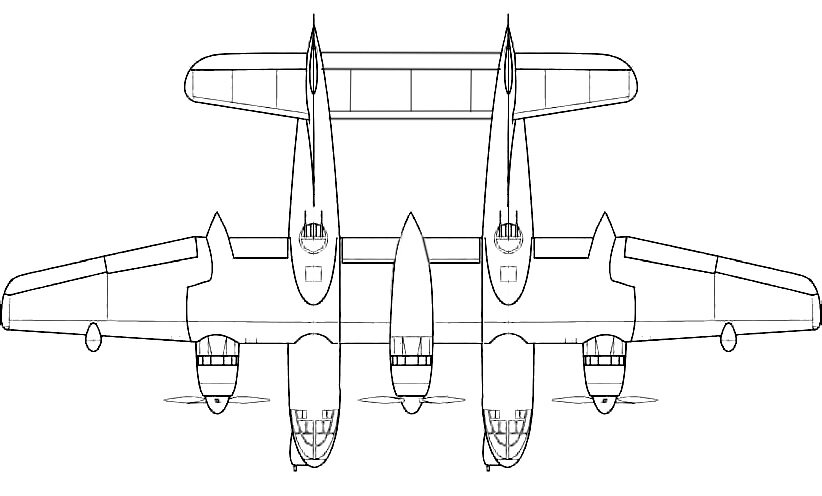VTB2F1/Ar, Conf File
Navy Dept, BuAer, Wash 25, D.C.
VTB Designs Comments
Cancellation of the TB2F will undoubtedly establish a policy in BuAer which will limit the size of carrier aircraft to a maximum of 26,000 lbs gross weight. This weight sets a definite limit on range and bomb load. If high speed is paramount in a torpedo bomber, it is believed that a single seat, single engine, light plane should be developed. This desk considers that the TB2F is worth trying. A long range plane with a large bomb capacity capable of operating from a carrier should have some tactical advantages. In regard to the basic ltr the following comments are made:
a. Original plane was designed only for the CVB carriers. It must be noted that the TB2D is designed only for the CVB and CV9 carriers.
b. An plane with the bomb load capacity of TB2F, and resultant weight, that can make 310 mph is considered to have excellent performance. A B25 and B26 will not carry this load at this speed nor land on a carrier.
c. Present take-off distance of a TB1D is 480 feet in a 25 Knot wind. TB2D with 2 torpedoes is estimated to be 485 ft in 25 knot; the SB2C with 2 1000 lbs bomb is 670 ft in a 25 knot wind.
d. TB2D will spot about 6 planes per 100 ft. It is considered that the reason for building the larger carriers is to accommodate larger planes.
e. TB2D will also require jettisoning of bomb load if a landing on the carrier is necessary immediately after take-off.
f. A nose wheel extension may be required on the TB2D to obtain hangar clearance. Both Grumman and Douglas feel that they can satisfactorily accomplish this.
g. Clearances on carrier elevators are small on practically all carriers for all torpedo and dive bomber planes. Similar problems must be expected with F7F and the TB26.
In order to overcome the disadvantages listed in this memo, both range and bomb-load must be radically reduced. VTB feels that cancellation of the TB2F definitely commits the Navy to small short range carrier aircraft. Increasing horse power of present models will definitely result in increase take-off distance end weight. The TBM is now up to 18,000 lb and the only characteristics that can be improved is speed.
VTB recommends that new over-all dimensions and gross weights be established for the TB2F and Grumman be requested to investigate removal of weight to reach such figures. Since a majority of the objections to the TB2F listed in basic ltr apply almost equally to the TB2D, this desk is somewhat concerned the difficulties that may arise in carrier operations with this plane. Douglas Co. is at present manufacturing 3 different vertical tail configurations with following resultant tail heights over the deck:
A. - 17 feet
B - 18 ft 6 inch
C - 19 ft 6 inch
The final production tail will depend on flight tests of demonstration piece. Douglas feels that the 18' 6" height tail will be necessary to obtain satisfactory lateral stability. If this tail is required, nose wheel extension must be employed to reduce tail heights in the hangar. Ships Installations has indicated that this will be unsatisfactory aboard ship.
If the need for long range carrier torpedo bombers can be considered subordinate to ease of handling aboard ship, it is believed that both the TB2F and TB2D designs must be considered equally. Cancellation of one design jeopardizes the advisability of proceeding with other since identical problems are involved. The question now paramount is torpedo plane performance as compared to carrier handling facilities. Only small, light carrier type planes can be expeditiously handled on ship board.
W. W. Hollister.
- - - - - - - - - - - - - - - - - - - - - - - - - - - - - - - - - - - - - - - - - - - - - - - -
E & D Comment
Desirability of cancellation of TB2F depends on whether it is to be Navy policy to have a twin engine aircraft of maximum range and torpedo capacity which can be operated from the CVB class carriers. This airplane is admittedly a tight squeeze on CVB elevators and hangar deck. However, its size and weight cannot be appreciably reduced unless one torpedo is eliminated. Even in this case, if it is to remain a twin engine plane it's overall dimensions cannot be reduced enough to appreciably effect the deck spotting requirements.
Any thought that the F7F can be modified to produce a torpedo plane carrying one torpedo internally and still having same overall dimensions should be discarded. Such an airplane would be approx 49 ft long and thus not operable on CV elevators. Its spot would be practically the same as the TB2F.
It certainly does not appear that the TB2F would be desirable as part of the basic air group for CVB's. On the other hand it is believed that an alternate air group containing TB2F might be exceedingly useful for special purposes. In order to fully exploit all of the tactical capabilities of the CVB class it is believed that a moderate number of these planes should be built. Fike 5-22
- - - - - - - - - - - - - - - - - - - - - - - - - - - - - - - - - - - - - - - - - - - - - - - -
The TB2F can be operated from the CVB carrier. It would entail a reduced number of planes on both the flight and hangar decks and reduced speed of operation for the total complement (see Capt. Bolster's analysis attached*. However, this was known at the inception of the design. The only 2 adverse changes in characteristics since then have been (1) necessity for raising nose wheel in hangar (which should not be too difficult to do) and an increase of about 1000 lbs in weight empty due to provision for special equipment - 75 mm cannon, radar, extra overload guns, bomb sight, increase in armor plate provision.
For special missions this model would be capable of performing missions which no other plane can do. Therefore, it is believed that a limited number should be obtained.
In view of wide difference of opinion, it might be well to obtain the desires of the Fleet. If this is concurred in Engineering will draft, the letter stating impartially the pros and cons, getting Military Requirement's approval before its submission for signature.
The TB2D is in same boat. H. R. Oster. 5-26
- - - - - - - - - - - - - - - - - - - - - - - - - - - - - - - - - - - - - - - - - - - - - - - -
VTB2F1/Ar, Conf File
Aer-R-10-RFF, Memo, 20 May 44
From: Military Requirements.
To: Chief, BuAer.
Subj: Cancellation of XTB2F Project - Recommendation for.
1. Mock-up Board for the XTB2F convened at Grumman Aircraft Engineering Corporation 1 to 4 May. While the board was immediately concerned with the way in which the essentials of the mock-up conformed to the specification, there was much general discussion relative to the operational limits imposed by the weight and size of the model.
2. Military Requirements recommends that the XTB2F project be cancelled and that no further development of this model he undertaken.
(a) This plane because of its weight and size can only be used from CVB, and their weight and clearances make even this use appear impractical.
(b) In comparison with other types, the XTB2F is only slightly faster, 310 mph. as against 293 mph. for the TBY, and not up to the speeds of new design attack planes.
(c) The carrier take-off run is exceedingly long. Take off with 700 gallons (reduced fuel) is 449 feet, indicating an operational spot of 600 feet from the bow. Take-off with 960 gallons (full internal fuel) is 646 feet, indicating an operational spot of 725 feet from the bow.
(d) the large size of the plane greatly reduces the number of planes which can be carried per ship. Studies indicate that only 5 1/2 planes per 100 feet of flight deck can be accommodated, while current VTB types spot 10 to 12 planes per 100 feet of deck.
(e) The weight of the plane (35,000 lbs.) is greater than that for which the flight deck of the CVB is stressed (26,000 lbs.). An emergency landing immediately after take-off would require complete jettisoning of the bomb load which would still leave the plane at approximately 33,000 lbs.
(f) The height of the plane, 20' 1" over the tail, requires the use of unproven arrangement of a nose wheel extending device which lowers the tail to 17'. Handling in the hangar will be marginal, even on the CVB. Although the plane, 52'6" x 36.0' folded, will operate, unloaded only, on the two deck elevators, which are 54' x 46', it will not operate on the side elevator 54' x 34'.
Elevator operating strength:
26,000 lbs
46 seconds
Overload:
35,000 lbs
53 seconds
3. The advantages intended to be gained in this type were:
(a) Increased load and armament
(b) Increased rate of climb
(c) Increased range
Although the load and armament per plane is doubled, the number of planes that can be carried is less than one-half. It is considered that carrier types must maintain performance, as against range, equal or superior to other enemy types, both land and ship based. A carrier attack cannot be based on surprise alone. Surprise will no longer be achieved with enemy use of radar. Carrier success, then, must be based upon superior performance and local control of the air during raids, both over own carriers and over the target. Long range carrier types in which performance is sacrificed for range are inconsistent with this policy. For carrier VB and VTB, range equal only to that of VF is deemed necessary.
4. Military Requirements recommends that this project be cancelled for the following reasons:
(a) Marginal handling characteristics aboard ship.
(1) Overloads deck
(2) Overloads elevators
(3) Overloads catapults
(4) Increases maintenance difficulties
(5) Reduces utility and operational mobility
(6) Makes hangar clearance marginal
(b) Fewer planes per ship resulting in smaller bomb load per air group.
(c) Too much has been sacrificed for long range.
5. It is further believed that no useful purpose could be gained by building this plane as a Navy land-based plane.
(a) Its speed and range do not justify land-based use.
(b) Shore-based attack planes are not properly a function of the Navy.
R.F Farrington
Lt. Cmdr. USN
- - - - - - - - - - - - - - - - - - - - - - - - - - - - - - - - - - - - - - - - - - - - - - - -
Comment: Capt. Beakley has seen and agrees entirely with us. Farrington
- - - - - - - - - - - - - - - - - - - - - - - - - - - - - - - - - - - - - - - - - - - - - - - -
Your recommendation of 6/1 on routing sheet approved. Please proceed with cancellation of TB2F-1 project as outlined.
D. A. Ramsey
- - - - - - - - - - - - - - - - - - - - - - - - - - - - - - - - - - - - - - - - - - - - - - - -
Radar operator will have to also be radio operator and navigator. It is desirable also that he be capable of acting as relief pilot. The capacity for 2 aircraft torpedoes results in a bomb bay larger than that in A26, B25 or B26.
Fike 5-10
- - - - - - - - - - - - - - - - - - - - - - - - - - - - - - - - - - - - - - - - - - - - - - - -
I still consider XTB2F as to large and too heavy to be a satisfactory plane for CBV's. See my remarks in mockup report.
Quilton 5/12
- - - - - - - - - - - - - - - - - - - - - - - - - - - - - - - - - - - - - - - - - - - - - - - -
In my opinion we are wasting money, manpower and time to continue with TB2F. It should be stopped as of today.
Jones 5-26
- - - - - - - - - - - - - - - - - - - - - - - - - - - - - - - - - - - - - - - - - - - - - - - -
I concur heartily with comments of Military Requirements. Recommend immediate cancellation.
Cornwall 5-26
- - - - - - - - - - - - - - - - - - - - - - - - - - - - - - - - - - - - - - - - - - - - - - - -
Concur with above, for this war the CVB's will be tactically more useful operating CV9 based aircraft types.
Temple 5-29
- - - - - - - - - - - - - - - - - - - - - - - - - - - - - - - - - - - - - - - - - - - - - - - -
I recommend that the XTB2F-1 project be cancelled, but that the contract be not terminated until Grumman has opportunity to discuss alternative projects. This can be done by issuing a stop-work notice on XTB2F-1 planes, engineering data, etc.
Richardson 6-1-44.
- - - - - - - - - - - - - - - - - - - - - - - - - - - - - - - - - - - - - - - - - - - - - - - -
VTB2F1/Ar, Conf File
Aer-E-17-WWH,. Navy Dept, BuAer, Wash 25, D.C., 8 May 1944
From: VTB Design Branch
To: Director of Engineering
Subj: XTB2F Plane.
1. Mock-up board for inspection of XTB21 plane convened at Bethpage on 1 May and adjourned on 4 May. Major changes recommended by board were:
(1) Complete revision of the cockpit. Revision eliminates any future installation of dual controls since the engine controls were moved to pilot's left hand side.
(2) Modification of fuselage near aft end of bomb bay to install MK-15 optical bombsight.
(3) Total revision of armor plate protection for crew members.
(4) Increase in no. of crew members from 3 to 4, i.e. pilot, top gunner, bottom gunner and radar operator.
2. Considerable objections raised in regard to size and weight of this plane. Large CVB Class carriers will be provided with elevators 54 ft. long by 46 ft. wide. TB2F will have an overall length of 52' 6". Clearance in the hangar deck will be marginal since the nose wheel of the plane must be extended to reduce tail height to 17 ft. Elevator and flight deck capacities are for 26,000 lbs. while plane empty will weight 23,650 lbs. Catapults, Mk-5, are designed for 30,000 lbs. at 90 mph, and TB2F, with two torpedoes, will weigh 35,000 lbs. Although some of the dimensions and capacities are exceeded, it will not be impossible to operate this plane from CVB Class carriers.
3. Although there are many disadvantages to the size and weight of the TB2F for carrier operations, it is considered that some of these disadvantages in handling must be accepted in order to obtain the advantage of long range (775 mile combat radius) and ability to carry two torpedoes (4400 lbs bomb load). If these advantages are desirable and considered necessary by the fleet, the size and weight of the TB2F must be accepted. It is not believed possible to reduce the size or weight of such an airplane without drastically reducing range, or eliminating one torpedo.
W. W. Hollister, Cmdr USN
- - - - - - - - - - - - - - - - - - - - - - - - - - - - - - - - - - - - - - - - - - - - - - - -
CVB41/VV, NAVY DEPT, Confi May 24, 1944
Subj: XTB2F - CVB41 Spotting Study Take-off Runs in a 25 kn wind (Calculated – no safety factor)
XTB2F-1
34515# - 449 ft
37027# - 546 ft
45070# - 942 ft
Airplane cannot be flown off in the maximum overload (45070#) from a CVB Class Carrier; it can be catapulted in a 35 kt. wind.
Hanger deck spot = 33 (Assuming 17'0" overall height)
Flight Deck Spots = 20 (with 1 torpedo at 34515#) This allows for a 560 ft T.O. run, 900 gals T.Complement 35 (including 25% safety factor)
Landing Spot - 20 TB2F's allows a barrier penetration of 116 ft through B6a.
Landing Spot - 24 TB2F's allows a barrier penetration of 80 ft through B5a
Catapult Conditions:
Catapult-operations
Hangar Deck 22
Flight Deck 24
Total 46
Catapult-Ferry
Hangar Deck 22
Flight Deck 41
Total 63
This permits both catapults to be clear for initial launching
Hangar Deck 22
Flight Deck 44
Total 66
This permits use of only one catapult until 3 planes have been launched.
C.M. Bolster
- - - - - - - - - - - - - - - - - - - - - - - - - - - - - - - - - - - - - - - - - - - - - - - -
COMMENT:
The CVB, being larger than the CV; CVL and CVE has a larger turning radius and is in general less maneuverable. The greater size makes it an easier bombing and torpedo target. Not withstanding its larger flight deck and hangar deck, it has only one take-off area and one landing area. Consequently group take-off and landing time will be greater in proportion to the greater plane capacity. The one outstanding tactical characteristic which the CVB has which, none of the smaller carriers have is its ability to handle larger aircraft. The TB2F is an obvious attempt to provide something comparable to the B25 and B26 which can be operated from a CVB. The necessary lower landing speed and shorter take off make it actually larger wing area than either of B25 or B26. The size of the plane cannot be appreciably reduced without reduction of bomb bay size to a point which reduce torpedo capacity from 2 to 1, Such a change puts it in the class with TBF (which will still be must smaller). The size of the TB2F has not grown since its inception. Neither has the weight except for the overload condition intended for shore based operation. Admittedly it cannot be handled with ease from a CVB but it can be handled. I believe that if the tactical conception of the CVB is sound it is considered that the TB2F is sound.
Fike 5-16

